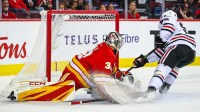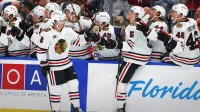The Chicago Blackhawks were one of the most active teams during the 2021 NHL offseason.
The team made some massive additions, in a clear attempt to compete now. They acquired defenseman Seth Jones from the Columbus Blue Jackets, goaltender Marc-Andre Fleury from the Vegas Golden Knights, forward Tyler Johnson from the Tampa Bay Lightning, and also signed defenseman Jake McCabe in free agency.
The deals for Fleury and Johnson saw the Blackhawks part with only Brent Seabrook’s contract and low-level prospect, while also netting a second-round pick in the process. However, the Seth Jones trade was very different.
In exchange for Jones and the 32nd overall pick in this year’s draft (as well as a 2022 sixth-round pick), the Blackhawks traded away defenseman Adam Boqvist, the 12th and 44th picks in the 2021 draft, and an additional first-round pick next year. The Blue Jackets then used the 12th pick to select Cole Sillinger, who’s one of three players from the class already playing in the NHL, and dealt the 44th pick to the Carolina Hurricanes for defenseman Jake Bean, who was a former 13th overall pick himself. So unlike Fleury, Johnson and McCabe, Jones did not come cheap, and the Blackhawks then proceeded to sign him to an eight-year extension at a $9.5 million cap hit.
Between the four players, the Blackhawks have dedicated a massive $21.4 million this season, or roughly 26 per cent of their cap space – and so far, the gambles have not paid off.
Chicago has opened the season with five straight losses.
So far, Fleury has a brutal .840 save percentage in his first three games of the year. Then say what you want about plus/minus as a stat, but Jake McCabe and Seth Jones are each a minus-six already.
It’s an incredibly disappointing start, given that Fleury is coming off winning a Vezina Trophy and the Blackhawks traded away key pieces of their future in order to get Jones, and dedicated a huge amount of additional cap space for Johnson and McCabe.
Now, this isn’t meant to charge blame directly to those players or criticize all of the decisions made. In fact, picking up Fleury basically for free, getting a pick just to take on a very solid depth forward in Tyler Johnson, and adding Jake McCabe were all strong moves in general.
However, looking at a larger scale, the Blackhawks took a gamble with their direction as an organization. They’re at least five years past their prime at this point and had qualified for the playoffs just once in the last four seasons (and even that was due to a qualifying round upset in the bubble, where they were the 12th seed in the Western Conference).
The only legitimate high-end players they had were Patrick Kane, who’s now 32 years old, Jonathan Toews, who didn’t play last season, Kirby Dach, who’s still developing and is just 20 years old, Alex DeBrincat, and maybe Dominik Kubalik. There was certainly an argument to look at the roster and realize that following through with a legitimate rebuild was long overdue.
Instead, the Blackhawks decided that this was the time to try and compete once again. In doing so, they traded away key future assets in the Jones trade, which could further derail their success. As for the other additions, an argument could be made that many of the decisions came with little risk, given that it just took cap space to bring in the players and the team had also offloaded Duncan Keith's $5.5 million cap hit. That said, Fleury's deal is the only one that could come off the books next offseason, meaning bringing in these players wasn't necessarily just a short-term commitment.
The issue is that the Blackhawks seemingly don’t have enough other pieces around the players they brought in to legitimately contend. So they moved future assets and used up their cap space, but may still not actually have a roster that’s going to be able to truly compete – and now they're down future assets.
Plus, one key factor to remember here is that extra first-round pick the Blackhawks gave up in the Jones deal. There is a condition that should Chicago win one of the draft lotteries next year, the pick will be transferred to 2023 instead. That said, there’s still a very high chance that if the Blackhawks can’t turn things around quickly, they’ll end up forfeiting a very good pick.
In all fairness, it’s also still very, very early in the season. Perhaps it’s just a slow start, the team turns things around and the new additions play a huge role in getting the Blackhawks back to contender status. However, should the Blackhawks continue on to have a poor season, it means their huge offseason gambles didn’t pay off and they’re in a worse spot than they were heading into this season.







